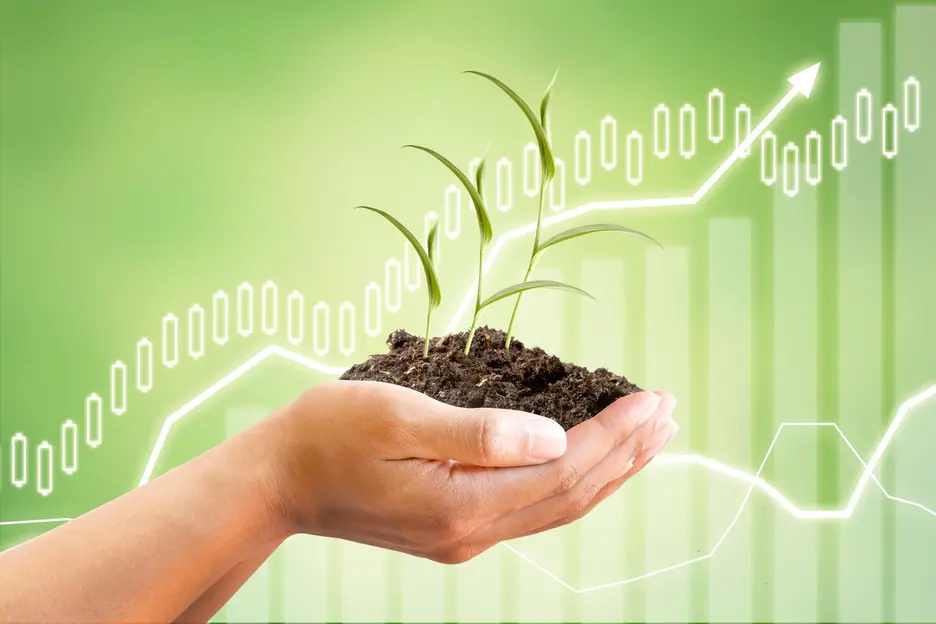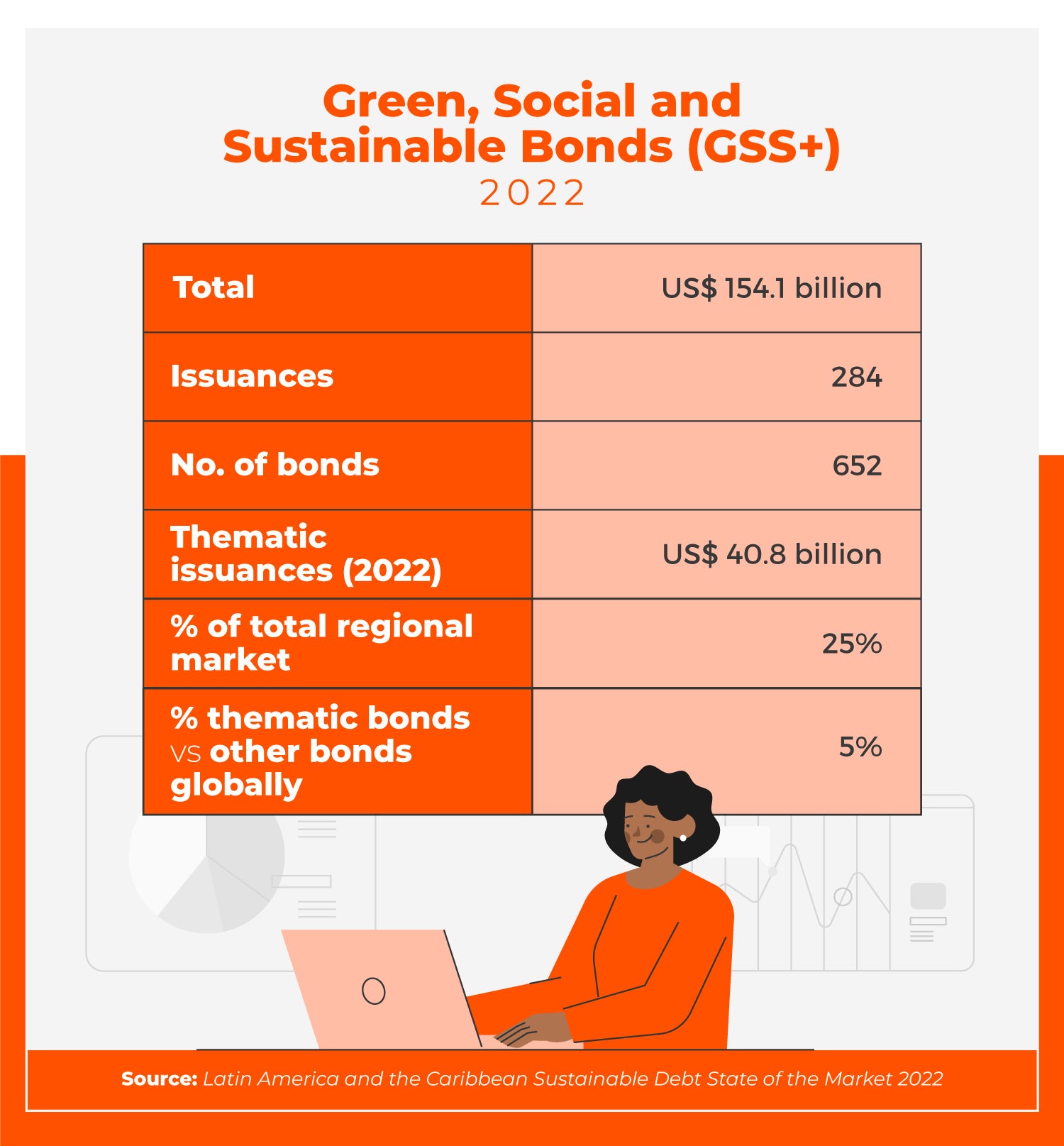Trending: Markets' Growing Appetite for Sustainability

Social, green, sustainable or sustainability-linked bonds (SLBs), jointly known as theme debt, may be crucial to attract capital to develop technologies involving low carbon emissions and policies and programs to bridge the social gap.
Moreover, this type of asset is well-positioned in a fast-developing investment community interested in environmental, social and governance (ESG) matters and is a fundamental drive for the economic growth and sustainable development of the region.
More reading on sustainable finance
A Sustainable Opportunity for Paraguay
Three ways to protect the sustainability-linked bond market
The largest issuers of green, social, sustainable and sustainability-linked bonds (GSS+) in the region are Brazil ($7.2 billion in 2022), Chile ($8.1 billion) and Mexico ($13.9 billion). However, the market shows a wider geographical distribution given the participation of other 20 countries.

By the end of 2022, cumulative green, social, and sustainability debt had reached $126.8n, a 160% increase since June 2021 ($48.6BN). Transition and sustainability-linked bonds, included for the first time in this regional analysis, add $27bn.
Between 2022 and 2023, we witnessed how local currency markets grew thanks to the increase in local currency issuances. In 2023, this type of issuances accounted for 36%, up from 23% accumulated between 2014 and 2021. This diversification is also reflected in the funded categories and the market labels.
For example, Bancolombia was the first financial institution in the region to issue SLBs. This COP 640 billion issuance was supported by IDB Invest and LAGreen Fund, and included environmental key performance indicators (KPI) —to reduce CO2 emission intensity— and social KPIs to focus on the financial inclusion of unbanked groups.
Hottest trends
- Adaptation and resilience
- Nine of the 20 countries with the highest exposure to climate change risks are in the LAC region. Responding to financing shortages and mobilizing capital to build resilience are central to facing current losses and avoiding future impacts.
- By the end of 2022, the proceeds of 22% of issued theme bonds were used for resilience matters. This figure is higher than the global average (19%) thanks to the issuances from governments or development banks.
- Taxonomies
- National taxonomies emerge as a key trend, as they enable the identification of local market features, such as the relevant economic sectors or core areas, to achieve sustainability and climate change goals.
- The region has made a big effort to develop this tool, with Colombia pioneering in 2022 with the publication of “Taxonomía Verde de Colombia” (Colombia’s Green Taxonomy), followed by Mexico with its “Taxonomía Sostenible de México” (Mexican Sustainable Taxonomy) in 2023. Brazil has also added the use of taxonomies for an easy alignment of public investment projects with the commitments in its National Decarbonization Plan.
- Sustainability-Linked Bonds (SLB)
- Sustainability-linked bonds are unique and innovative, as they link the coupon with predetermined sustainability results that lead to material environmental or social improvements, as the case may be.
- The flexibility they offer explains why the region has increasingly turned to SLBs, and how important it is to keep innovative schemes that contribute to reaching sustainability objectives with substantial environmental impacts and relevant social impacts.
- Gender
- Latin America and the Caribbean are global pioneers in gender bonds exclusively earmarked to funding women-led or women-women SMEs, accounting for almost 50% of the emissions.
- There is a considerably increasing demand for adding a gender lens to theme bonds, including SLBs, and the trend is apparent both in public and private issuances.
- This has favored cross-cutting and structural strategies of financial inclusion, anti-discrimination, leadership and empowerment, etc., which contribute to closing the structural gender gaps in the countries, and more granularly down at the sector level.

IDB Group: support and transparency
The IDB Group is committed to supporting the development of sustainable financing markets and building skills in the relevant market stakeholders. It has supported 86 issuances, amounting to $44.035 billion. In fact, 27% of the volume issued in the region has been supported by the institution.
Such efforts as the Latin America and the Caribbean Sustainable Debt State of the Market 2022 report, as prepared by CBI and the IDB, and the development of regional public initiatives like the Green Bond Transparency Platform and the Green Finance LAC platform are key for success.
These supportive actions have been instrumental for market innovation. Also, the Group promotes a favorable policy and market environment, which enables adequate regulatory frameworks, as well as international regulatory coordination and harmonization and investments in key activities.
Latest blogs
Will technology transform education? Certain conditions apply
Latin America: The Future of Value Chains Smells like Chocolate
LIKE WHAT YOU JUST READ?
Subscribe to our mailing list to stay informed on the latest IDB Invest news, blog posts, upcoming events, and to learn more about specific areas of interest.
Subscribe



